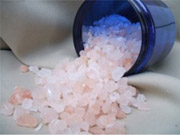
The phenomenon of “bath salts” abuse and dependence is hard to believe. Nevertheless, since late 2010 young people and adults have been swallowing, smoking, sniffing, and injecting dangerous white or colored powders that they purchase from head shops, convenience stores, or the Internet.[NIDA Message] Colorful packages with catchy names such as Arctic Blast, Cloud 9, Ivory Wave, Snow Leopard, Vanilla Sky, and White Lightning may contain 50 milligrams or more of powder and sell for $25-50. They are labeled as bath additives (or glass cleaner or plant food) that are “not intended for human consumption.” How this can be happening?
Neurobiology helps explain it. Basically, addiction doesn’t make sense: people with addiction pursue their relationship with a mood-changing chemical even when it ruins their body and other relationships. This happens because: (1) addictive substances provide reward and escape that condition the user to seek the substances over and over; (2) stopping the substance prompts discomfort and displeasure, which motivate continuous use; and (3) should people with addiction manage to stop using, they often start right up again if they get too close to the substance. The deeper, primitive brain drives this behavior while the more evolved, conscious, “executive” brain, which might otherwise restrain it, is so muddled by addiction that obtaining and using the substance ranks higher than personal safety, family, career, and community. Yet even with this scientific understanding, addictive behavior can be so dramatically self-defeating that it’s hard to believe!
Household product disguises make bath salts “legal” for sale, but makers, sellers, and buyers all know these products are designer drugs—synthetic chemicals with effects similar to cocaine, methamphetamine, or ecstasy. Common ingredients are MDPV and mephedrone, which are similar to naturally occurring cathinone, an abused amphetamine-like substance obtained from the African khat plant. The drugs in bath salts increase the activities of dopamine, norepinephrine, and serotonin in the brain. [Cleveland Clinic] Users experience a powerful and addictive high. But users also frequently experience dangerous and terrifying mental and physical effects including pounding heart, chest pain, agitation, aggression, muscle pain, nausea and vomiting, twitching, seizure, teeth grinding, sweating, elevated body temperature, confusion, hallucinations, paranoid delusions, and suicidal thoughts. Permanent damage to the heart or brain, even death, may result from the use of these drugs.
A thirty-year-old man—fighting his own problems with alcohol, opioids, benzodiazepines, marijuana, and cocaine—said about bath salts, “I can’t believe anyone would ever use that stuff!” But people do; individuals with psychosis and other complications caused by bath salts continue to present to law enforcement and emergency medical personnel. Factors behind their use include permissive attitudes toward drug experiences, adolescent rebelliousness and risk taking, the distortions of addictive “thinking” [Addict’s Story], and drug availability. State and Federal authorities have enacted bans and are seeking to further block the availability of these drugs. Legislation passed by Congress in June [Synthetic Drug Act] and signed by the President in July may help, but some fear it is not comprehensive enough. [ABC News]
Those charged with enforcing laws against these harmful substances will need to be vigilant. Last October when a group of drug users complained to a convenience store clerk that they couldn’t find bath salts the clerk said, “Oh, now they’re stain remover.”
